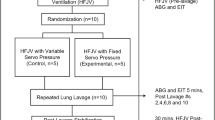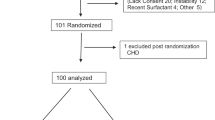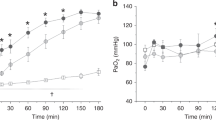Abstract
OBJECTIVE: To determine if high-frequency oscillatory ventilation and neuromuscular blockade improve oxygenation and chest radiographic appearance more effectively than high-frequency oscillation alone for surfactant protein-B (SP-B)–deficient infants.
STUDY DESIGN: We reviewed medical records and chest radiographs of five SP-B–deficient infants awaiting lung transplantation. Changes in FiO2 and radiographic scores were analyzed with respect to neuromuscular blockade status.
RESULTS: FiO2 consistently increased 0.20 (SD 0.11) during high-frequency ventilation without neuromuscular blockade (p=0.02) and decreased 0.14 (SD 0.11) during high-frequency ventilation with neuromuscular blockade (p=0.05). Chest radiographic appearance, quantified by an expansion/aeration index, consistently deteriorated without neuromuscular blockade (p=0.01) and consistently improved with neuromuscular blockade (p=0.03). Changes in FiO2 correlated with changes in radiograph scores (r=0.7, p<0.001).
CONCLUSIONS: High-frequency ventilation with neuromuscular blockade optimizes oxygenation for SP-B–deficient infants. This ventilatory strategy should be considered while awaiting the diagnosis of SP-B deficiency or lung transplantation.
This is a preview of subscription content, access via your institution
Access options
Subscribe to this journal
Receive 12 print issues and online access
$259.00 per year
only $21.58 per issue
Buy this article
- Purchase on Springer Link
- Instant access to full article PDF
Prices may be subject to local taxes which are calculated during checkout
Similar content being viewed by others
References
Nogee LM, DeMello DE, Dehner LP, Colten HR Deficiency of pulmonary surfactant protein-B in congenital alveolar proteinosis N Engl J Med 1993 328 406–10
Hamvas A Inherited surfactant protein-B deficiency Adv Pediatr 1997 44 369–88
Nogee LM, Garnier G, Singer L, et al A mutation in the surfactant protein B gene responsible for fatal neonatal respiratory disease in multiple kindreds J Clin Invest 1994 93 1860–3
Hamvas A, Nogee LM, Mallory GB, et al Lung transplantation for treatment of infants with surfactant protein B deficiency J Pediatr 1997 130 231–9
Hamvas A, Cole FS, deMello DE, et al Surfactant protein-B deficiency: antenatal diagnosis and prospective treatment with surfactant replacement J Pediatr 1994 125 356–61
Nogee LM, Ballard PL, Ballard RA, et al A new mutation producing partial surfactant protein-B deficiency in a compound heterozygote Pediatr 1995 96 1046–52
Rosner B Fundamentals of Biostatistics 2nd ed Boston: Duxbury Press 1986
Clark RH, Gerstmann DR Controversies in high-frequency ventilation Clin Perinatol 1998 25 113–22
Wolfson MR, Shaffer TH Differential effects of pancuronium bromide on cardiopulmonary function in the neonatal lamb Pediatr Pulmonol 1990 8 233–9
Miller J, Law AB, Parker RA, Sundell H, Silberberg AR, Cotton RB Effects of morphine and pancuronium on lung volume and oxygenation in premature infants with hyaline membrane disease J Pediatr 1994 125 97–103
Bhutani VK, Abbasi S, Sivieri EM Continuous muscle paralysis: effect on neonatal pulmonary mechanics Pediatrics 1988 81 419–22
Nagase T, Fukuchi Y, Matsuse T, Shimizu T, Orimo H Reduction of 15-hydroxyeicosatetraenoic acid (15-HETE) in tracheal fluid by high frequency oscillatory ventilation Prostaglandins Leukotrienes Essent Fatty Acids 1990 40 177–80
Imai Y, Kawano T, Miyasaka K, Takata M, Imai T, Okuyama K Inflammatory chemical mediators during conventional ventilation and high frequency oscillatory ventilation Am J Respir Crit Care Med 1994 150 1550–4
Takata M, Abe J, Tanaka H, et al Intra-alveolar expression of tumor necrosis factor-alpha gene during conventional and high frequency ventilation Am J Respir Crit Care Med 1997 156 272–9
Chander A, Fisher AB Regulation of lung surfactant secretion Am J Physiol 1990 258 L241–53
Oyarzun MJ, Iturriaga R, Donoso N, et al Factors affecting distribution of alveolar surfactant during resting ventilation Am J Physiol 1991 261 L210–7
Nicholas TE, Power JHT, Barr HA Effect of pattern of breathing on subfractions of surfactant in tissue and alveolar compartments of the adult rat lung Am J Respir Cell Mol Biol 1990 3 251–8
Hildebran JN, Goerke J, Clements JA Surfactant release in excised rat lung is stimulated by air inflation J Appl Physiol 1981 51 905–10
Faridy EE Effect of distension on release of surfactant in excised dog's lungs Resp Physiol 1976 27 99–114
Ikegami M, Wada K, Emerson GA, Rebello CM, Hernandez RE, Jobe AH Effects of ventilation style on surfactant metabolism and treatment response in preterm lambs Am J Respir Crit Care Med 1998 157 638–44
Dargaville PA, South M, McDougall PN Pulmonary surfactant concentration during transition from high frequency oscillation to conventional mechanical ventilation J Paediatr Child Health 1997 33 517–21
Bunt JEH, Zimmermann LJ, Wattimena JLD, van Beek RH, Sauer PJ, Carnielli VP Endogenous surfactant turnover in preterm infants measured with stable isotopes Am J Respir Crit Care Med 1998 157 810–4
Cogo PE, Carnielli VP, Bunt JEH, et al Endogenous surfactant metabolism in critically ill infants measured with stable isotope labeled fatty acids Pediatr Res 1999 45 242–6
Acknowledgements
We thank Corrine Hamvas for data acquisition, F.S. Cole, MD, for review of the manuscript and Dawn Rouse for secretarial assistance.
Author information
Authors and Affiliations
Additional information
This study was supported in part by National Institutes of Health HL/HD54187 (A.H.). An abstract based on these data was presented at the American Thoracic Society International Conference, 16–21 May 1997, San Francisco, CA (Am J Respir Crit Care Med 1997;155:A236).
Rights and permissions
About this article
Cite this article
King, E., Shackelford, G. & Hamvas, A. High-Frequency Oscillation and Paralysis Stabilize Surfactant Protein-B–Deficient Infants. J Perinatol 21, 421–425 (2001). https://doi.org/10.1038/sj.jp.7210555
Published:
Issue Date:
DOI: https://doi.org/10.1038/sj.jp.7210555



